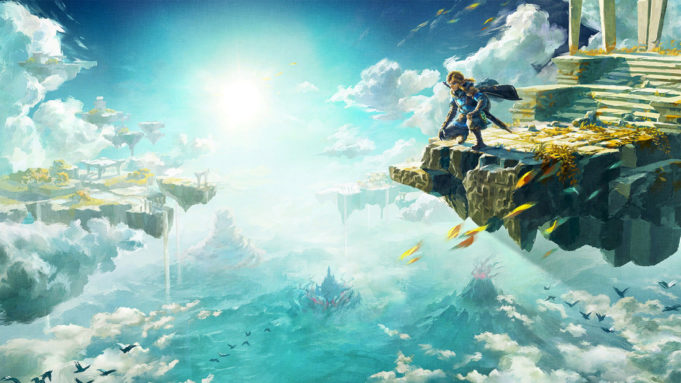The Legend of Zelda: Tears of the Kingdom is not a perfect game. The frame rate drops, not often but noticeably, and in strange moments, such as when you’re just rotating the camera, textures can still look muddy up close and repeat in obvious patterns from far away. And near the end of the main storyline, there’s one quest that’s pretty much just padding. And yet those criticisms can’t prevent the game from being anything but what it is: a masterpiece that somehow tops its estimable predecessor.
Breath of the Wild in 2017 helped launch the newly released Switch console while also revamping the Zelda series’ well-worn gameplay. Tears takes what Breath did, offering an interactive physics system for players to explore while expanding and refining an expansive open world into something not entirely new but entirely amazing.
Set a few years after the original, Tears finds a deadly miasma called Gloom draining people in the kingdom of Hyrule of their lifeforce. Seeking its source leads heroic knight Link (Kengo Takanashi) and Princess Zelda (Patricia Summersett) into the depths of Hyrule Castle, where they encounter the desiccated corpse of series heavy Ganondorf (Matthew Mercer), who quickly revives and unleashes a disaster known as the Upheaval. Zelda disappears, and Link is badly injured. When he wakes up, he has a magical new arm and finds himself on a floating island in the sky. Now, it’s up to players to face new dangers, explore the vastly altered landscape, and find the missing princess.
Like Breath, Tears remains a massive open-world single-player adventure. The game largely reuses Breath’s map, but thanks to the time passed and the Upheaval, locations are greatly altered, from volcanoes cooling to bridges collapsing to villages becoming fashion hotspots. Tears changes more than just enough to make exploring its world a new experience, managing to invoke both nostalgia and a sense of discovery. And literally on top of things are the islands in the sky that Link reaches by launching himself out of watchtowers and that are filled with hidden treasures and extra enemies to battle. And on top of that — or, rather, below all that — there’s the Depths. A third map hundreds of feet below Hyrule where darkness reigns and Gloom saps Link’s maximum number of hearts, the Depths are also where special stones called Zonite abound, allowing Link to upgrade his powers.
And with a new game and Link’s new arm come new abilities — the two most prominent are Fuse and Ultrahand. Fuse improves one of Breath’s most criticized mechanics, breakable weapons, by allowing you to put almost anything on your equipment, from explosive bombs on your shields that blast enemies to useless apples attached to arrows and entire minecarts placed on your swords for no reason, meaning every broken weapon is no longer a frustration but a chance to make something new and daring or silly and useless. Ultrahand lets players attach just about any object to something else. You can take planks of wood and make walkways across rivers or use machine parts called Zonai devices to make boats, motorcycles, flame-throwing robots, and more. The freedom to create almost anything you wish is astonishing and gives players a whole new way to interact with the world.
That freedom also includes how you pursue the game’s many quests. From the main story of finding Princess Zelda to side quests like working for a newspaper or helping people find their lost pets, there’s a wealth of things to do in Tears. And speaking of the main story, it’s also a major upgrade on Breath’s, providing twists and turns and more than a few actual tears.
However, the freedom of exploration also means the game’s story — about half of it is told via cutscenes hidden in collectibles — can be told out of sequence if players aren’t careful. And important game mechanics, from the machine-making Autobuild power to the ability for players to use the in-game camera, can also be entirely missed. In those cases, the game’s commitment to freedom could have used some reining in.
As for performance, it’s a small miracle the game runs as well as it does on the Switch’s aging hardware. There are times when the seams are visible, such as the aforementioned framerate drops, but even in handheld mode, the game runs smoothly, and there wasn’t one crash after almost 100 hours of playtime.
Tears of the Kingdom isn’t just a grand adventure and one of the best things Nintendo has produced. It’s a game that’s simply fun to play, moment to moment, hour after hour. Anyone with a Switch, or wanting an excuse to buy one after all this time, owes it to themselves to play this game.
The Legend of Zelda: Tears of the Kingdom
Directed by Hidemaro Fujibayashi. Produced by Eiji Aonuma. Starring Patricia Summersett, Matthew Mercer, and Kengo Takanashi. Available for Nintendo Switch. $69.99.
Rated E for Everyone.












